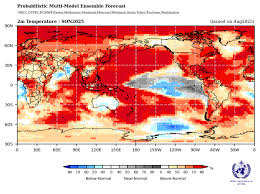
New modelling suggests the tipping point that makes an Amoc shutdown inevitable is likely to be passed within a few decades. Photograph: Henrik Egede-Lassen/Zoomedia/PA
| Published September 1, 2025
📰 Key Claims from the Guardian Article (August 28, 2025)
-
-
AMOC at weakest in 1,600 years
-
Researchers argue the Atlantic current is already at historically low strength based on reconstructions and model comparisons.
-
-
Collapse risk no longer considered “low likelihood”
-
A new study suggests collapse is now within the range of realistic outcomes, not just a remote possibility.
-
-
Probabilities by emission scenario
-
High emissions → up to 70% chance of collapse.
-
Intermediate emissions → about 37% chance.
-
Low emissions → still 25% chance (meaning even strong climate action may not eliminate risk).
-
-
Timing of tipping point and collapse
-
Tipping point could be crossed within 10–20 years (mid-21st century).
-
Full collapse would then occur 50–100 years after crossing the threshold.
-
-
Consequences of collapse (if it happens)
-
Extreme weather shifts:
-
Colder, harsher winters in Europe.
-
Major droughts in the Sahel region of Africa.
-
Reduced monsoon rainfall in South Asia and South America.
-
-
Sea level rise of up to 50 cm (20 inches) along the U.S. east coast.
-
Disrupted rainfall patterns across the tropics.
-
-
Urgency of emissions cuts
-
Researchers argue cutting carbon emissions rapidly is the best way to avoid triggering collapse.
-
-
Limitations of the models
-
Authors admit their study did not include the effect of Greenland meltwater, which could make collapse even more likely in reality.
-
-
Overall framing
-
The Guardian presents the study as a wake-up call, framing collapse as a real possibility within human lifetimes rather than a far-off theoretical event.
-
-
Today we’re going to talk about the Atlantic Meridional Overturning Circulation, or AMOC. Some scientists warn that this ocean current—which moves warm water north and cold water south—could eventually collapse because of global warming. You may have read headlines saying this could cause extreme winters in Europe, rising sea levels, or even a global climate crisis.
But let’s slow down and look at this carefully.
First, remember that science is about evidence, not headlines. The newest studies use computer models to predict what might happen hundreds of years into the future, sometimes up to the year 2500. The farther into the future we project, the more uncertain those results become. That’s like trying to predict the weather not next week, but 500 years from now.
Second, some recent research—like a Woods Hole Oceanographic Institution study—actually shows no measurable decline in AMOC over the last 60 years. That means in real-world observations, the system has held steady, even while models warn of collapse.
Third, the IPCC (Intergovernmental Panel on Climate Change) says that while weakening of AMOC is “very likely” this century, a sudden collapse before 2100 is considered only ‘medium confidence’—in other words, unlikely.
So why do we see such dramatic headlines? Because uncertainty often gets translated into certainty when presented to the public. Fear grabs attention. But as good critical thinkers, we should separate possible scenarios from proven trends.
In short:
-
Yes, AMOC weakening is a real concern.
-
No, there’s no solid evidence yet that collapse is imminent.
-
The best approach is to keep studying, gather more real-world data, and remain skeptical of dramatic claims until they’re backed by strong evidence.
This is how science should be taught—questioning, testing, and always cautious about predictions that sound too certain.”
 Counterpoint on Climate Change:
Counterpoint on Climate Change:
1. Model Uncertainty & Over-Reliance
-
Scientists often use computer models to simulate how the Earth’s climate and oceans might behave in the future. These models take in lots of variables: greenhouse gases, ocean temperatures, salinity, ice melt, and so on. Then, they ‘run’ scenarios to see what could happen under different emission levels.
Here’s the key point: models are only as good as the assumptions they’re built on. If one assumption is off—say, the rate of Greenland’s ice melt or how heat is transferred in deep water—the results can shift dramatically.
Think of it like this: If I give you a math problem with a small error at the beginning, by the time you get to the end, the answer could be way off. Climate models work the same way—errors compound over time.
Now, many of these AMOC collapse studies don’t just project to 2100 (about 75 years from now). Some stretch all the way to 2300 or even 2500. Imagine trying to predict not just who will win the next election, but who will win elections for the next ten generations! That’s how speculative these very long-term projections can be.
And here’s another important piece: different climate models often give different outcomes. Some predict a high chance of AMOC collapse, others predict almost none. For example, a 2021 study using 34 major climate models found that not one predicted an AMOC collapse by 2100. But newer models using different assumptions claim there’s up to a 70% chance under high emissions. Same system—very different answers.
So, when you hear scientists or the media saying collapse is ‘likely,’ we need to ask:
-
Which model are they using?
-
What assumptions went into it?
-
And how reliable are those assumptions over centuries?
That’s why skeptics stress caution: models are tools, not crystal balls. They can highlight risks, but they shouldn’t be treated as guaranteed predictions.”
-
- These warnings are more alarmist than scientific. For ocean currents to slow—or collapse—a thing or two has to happen:
The Earth would need to stop spinning,
Continents would need to alter their location, or
The Sun would need to stop shining.
CO₂ plays no part at all—not even indirectly.*In other words, natural forces govern ocean circulation, not human activity. Claims that CO₂ emissions can somehow overturn planetary-scale mechanics are, to many, nothing more than climate scare tactics.
2. Historical Stability Still Holds
-
The AMOC has been running for thousands of years, moving warm water from the tropics up toward Europe and sending cooler water back down south. It’s a key part of Earth’s climate system. Now, if this system were already breaking down, we’d expect to see strong, clear evidence in recent decades.
But here’s the surprise: a Woods Hole Oceanographic Institution study from 2025 analyzed 60 years of high-quality ocean data, and it found no measurable decline in the AMOC. In other words, despite all the talk of collapse, the system appears to be holding steady in the real world.
Think of it like this: Imagine your car engine has been running for 1,600 years. Some mechanics say it’s about to break down any day now. But when you actually open the hood and check it over the last 60 years, everything looks stable. Sure, there could be problems in the future, but the evidence today doesn’t show it’s failing right now.
Also, remember that natural systems like the AMOC have been through big climate swings before—ice ages, warming periods, even the Little Ice Age in Europe. Through all of that, the current weakened and strengthened naturally, but it never completely collapsed in modern human history.
This is what we point out:
-
The real-world data does not match the alarmist narrative.
-
The system has proven to be more resilient than some models suggest.
-
Historical patterns show natural ups and downs, not a straight-line path to collapse.
This doesn’t mean it’s invincible, but it does mean we should be cautious about assuming disaster when the observations tell a steadier story.”
-
3. Early Warning Signals Are Debatable
-
Researchers try to spot subtle changes in the ocean that could act like a ‘check engine light’ for the climate system. For example, they look at:
-
Variability in sea-surface temperatures
-
Salinity shifts (saltiness of water)
-
Or mathematical signals in data, like rising instability patterns
These are interesting approaches, but here’s the problem: the signals are not clear-cut.
Some studies claim these indicators show the AMOC is getting weaker and unstable. But other researchers argue that those same indicators might actually be statistical noise or artifacts of the method used. In fact, one recent review pointed out that earlier claims of ‘tipping point warnings’ could simply be the result of bias in the calculation method, not a true physical change in the ocean.
Think about it this way: Imagine your car dashboard flickers for a second. Does that mean the engine is about to fail? Not necessarily—it could just be a faulty sensor. The same goes for these so-called early warning signals.
Also, let’s remember that the AMOC is influenced by many different natural cycles—the North Atlantic Oscillation, volcanic eruptions, even solar activity. These can all cause short-term ‘wobbles’ in the data that might look like warning signs, but aren’t actually signs of collapse.
So from a our standpoint:
-
Yes, scientists are right to look for early warning signs.
-
But no, the evidence isn’t strong enough to say these signals prove collapse is coming.
-
We must separate genuine patterns from statistical noise.
That’s why skeptics urge caution: don’t treat a flicker of data as a prophecy of doom.”
-
4. Scientific Debate Persists
-
Some researchers, using simplified models, suggest the AMOC could collapse as early as 2065, with a wide range of possibilities between the 2030s and 2100. But critics point out that these models are much less complex than the advanced Earth System Models used by the IPCC. That means they might confuse a gradual slowdown with a total collapse, which are very different things.
On the other hand, the IPCC’s Sixth Assessment Report takes a more cautious stance:
-
It says the AMOC will “very likely” weaken during this century.
-
But it judges an abrupt collapse before 2100 as only ‘medium confidence’—which in IPCC language means unlikely but not impossible.
So we have two very different narratives:
-
Alarmist studies warning of collapse within decades.
-
Mainstream consensus saying a full collapse this century is improbable.
And this disagreement isn’t just academic. It shapes how the media reports on the issue. A headline like ‘AMOC Collapse Likely Soon’ grabs attention, while the more cautious IPCC message—‘Collapse is unlikely before 2100’—doesn’t sell as many newspapers.
Here’s the skeptical takeaway:
-
When experts themselves don’t fully agree, we should be careful about accepting dramatic claims at face value.
-
Science works best when it acknowledges uncertainty, not when it pretends to have all the answers.
-
Healthy debate means the case is not closed, no matter how much some outlets want to make it sound urgent.
In short: the AMOC question is still under debate, and that’s exactly why skepticism is both reasonable and necessary.”
-
5. Alternative Studies Offer Less Dramatic Outlook
-
Not all scientific studies predict a dramatic collapse of the AMOC. In fact, many point to a less extreme but still important scenario: a gradual slowdown rather than a sudden shutdown.
For example, one study found that even a slight weakening of the AMOC—say, 10–40%—could already have noticeable effects, like reducing rainfall in the Amazon or shifting monsoon patterns. That sounds serious, but notice the difference: it’s about slowing down, not collapsing completely.
Another study focused on Europe and suggested that the UK and surrounding regions might experience colder, drier winters by the end of the century. Again, this isn’t a global catastrophe—it’s a regional climate adjustment.
From a our perspective, these alternative studies are important because they remind us that:
-
Climate change impacts are often gradual, not sudden doomsday events.
-
Headlines that scream ‘collapse’ may be overselling what the science actually says.
-
A slowdown is scientifically plausible and already supported by some evidence, but a complete collapse is still speculative.
Think of it like this: If your car starts running a little slower, that’s a concern—you might need a tune-up. But that’s very different from the engine suddenly seizing and the car dying on the highway. The first scenario is manageable, the second is catastrophic. Many of these alternative studies suggest the first scenario, not the second.
So skeptics argue that focusing on a possible collapse distracts from the more realistic picture: gradual changes that we can adapt to and prepare for, instead of a Hollywood-style climate disaster.”
-
Summary Table – Counterpoint Lens
| Point of Skepticism | Counter-Context / Nuance |
|---|---|
| Reliance on extended projections | Models reaching to 2300–2500 are speculative and highly uncertain. |
| Claim of imminent collapse | Observations show no decline in the past 60 years; collapse is not yet evidenced. |
| Early warning signals | Proxies may be misleading; some warnings may stem from flawed methods. |
| Scientific consensus | IPCC places abrupt collapse before 2100 at medium confidence; many scientists still skeptical. |
| Impact focus | Even moderate AMOC weakening has major consequences—collapse isn’t required for concern. |
 Overall Takeaway:
Overall Takeaway:
The Guardian article paints a dramatic picture of the AMOC being on the verge of collapse. But when we step back and look at the full body of evidence, a more balanced story emerges.
-
Models vs. Reality – Computer simulations can project collapse centuries into the future, but actual ocean measurements over the last 60 years show no decline. Models are tools, not crystal balls.
-
Historical resilience – The AMOC has survived ice ages, warm periods, and natural variability without collapsing. History suggests it is more stable than headlines imply.
-
Warning signals uncertain – Some so-called ‘early warning indicators’ may just be noise or flawed methods, not real proof of instability.
-
Scientific debate is alive – While some researchers forecast collapse this century, the IPCC and many leading studies still consider it unlikely before 2100.
-
Alternative outlooks – Many studies show a slowdown, not a shutdown. That’s important, but it’s very different from an outright collapse.
So the takeaway is this:
Yes, the AMOC may weaken over time, and that could have regional impacts we should watch closely. But the evidence for a sudden, catastrophic collapse in our lifetimes is thin. The science is still unsettled, the signals are debated, and the system itself has proven resilient.
In other words, let’s treat collapse claims as possible scenarios, not inevitable facts.”





Be the first to comment